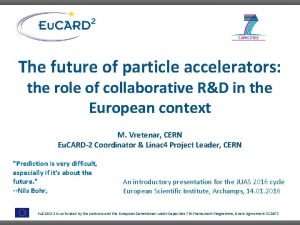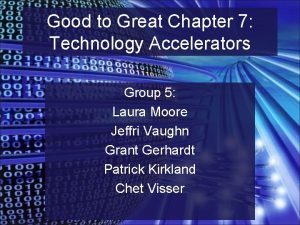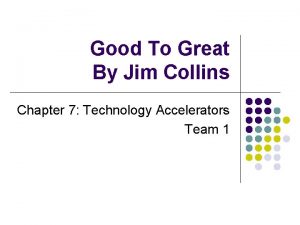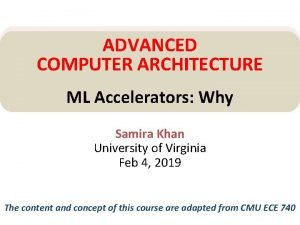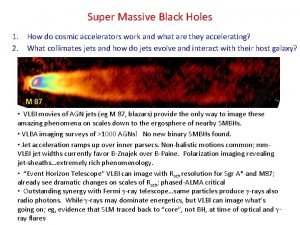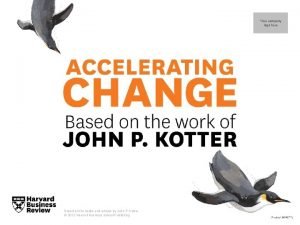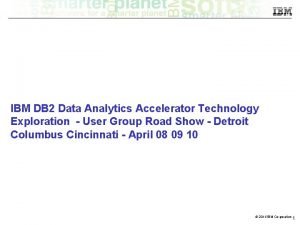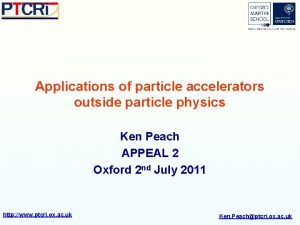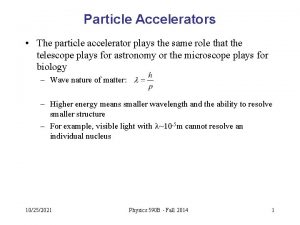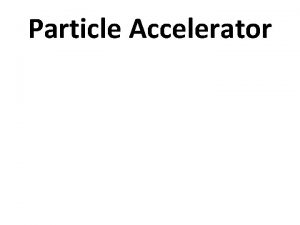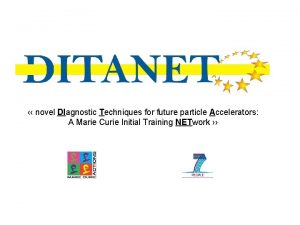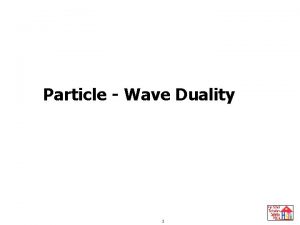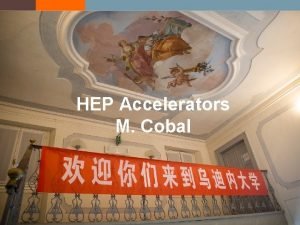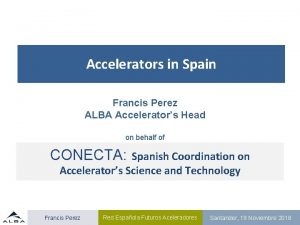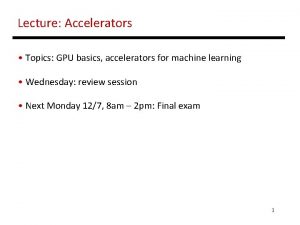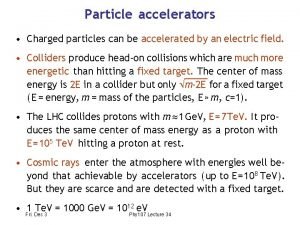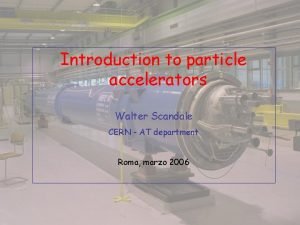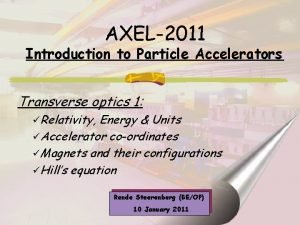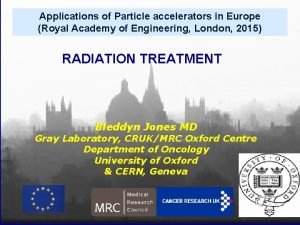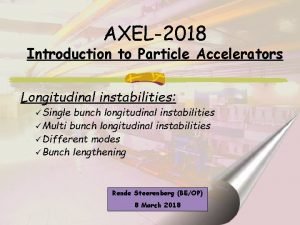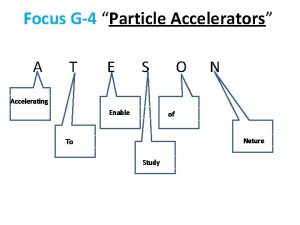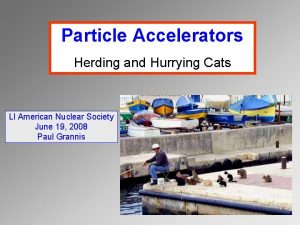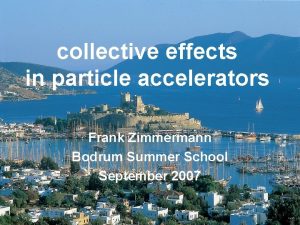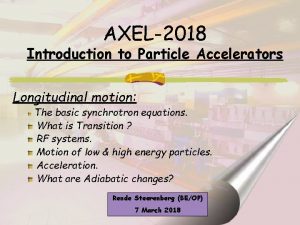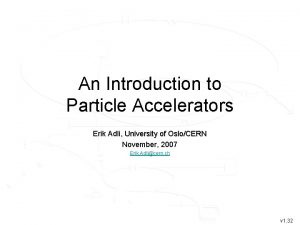The future of particle accelerators the role of
































- Slides: 32

The future of particle accelerators: the role of collaborative R&D in the European context M. Vretenar, CERN Eu. CARD-2 Coordinator & Linac 4 Project Leader, CERN "Prediction is very difficult, especially if it's about the future. " --Nils Bohr, An introductory presentation for the JUAS 2016 cycle European Scientific Institute, Archamps, 14. 01. 2016 Eu. CARD-2 is co-funded by the partners and the European Commission under Capacities 7 th Framework Programme, Grant Agreement 312453

Accelerators: a long history… 88 years since the invention of the first modern accelerator (i. e. using periodic acceleration provided by Radio-Frequency fields): Rolf Wideröe’s thesis, 1928 Acceleration of potassium ions 1+ with 25 k. V of RF at 1 MHz 50 ke. V acceleration (“at a cost of four to five hundred marks”…) 1. use of Radio-Frequency technology (at the time limited to 1 -2 MHz) → marrying radio technology and accelerators. 2. Use of a drift tube separating 2 accelerating gaps → invention of periodic accelerators. 3. complete accelerator: ion source, RF accelerator, detector, all in vacuum 88 cm long glass tube – total cost less than 500 Marks

The ingredients of Rolf Wideröe’s innovation: • A Ph. D student (fresh ideas and time available) • Under pressure to complete his thesis (necessity is the mother of invention) • Merging information and experience from different fields (cross-fertilisation)

From infancy to maturity 1931…………. 1945/48…. 1952…………. . 1965/90’s…. … 1928 Wideröe builds the first modern accelerator Cyclotron: cyclic acceleration with magnets (Lawrence) Strong focusing (Courant, Livingston, Snyder, Christofilos) Application of WW 2 radar technology to accelerators (Hansen, Alvarez) Superconductivity – magnets and cavities 2008 First beam in the Large Hadron Collider

And now? The 2016 accelerator landscape Are we coming to a saturation? But the field has never been so flourishing… TIARA, Need for Accelerator Scientists report, 2013: 3’ 700 people engaged in accelerator science in European research institutes, number expected to grow by 18% in 5 years. Updated Livingstone-type chart (Wikipedia 2014, uploaded by J. Nash, Imperial College) Accelerators are going through an impressive progress that at the moment more than by the quest for energy (basic science) is driven by aaplied science: x-ray or neutron sources, medical, etc. 5

Where are we going ? Collaborative R&D is needed for: 1 2 1931: Lawrence, cyclic acceleration 1928: Wideröe, periodic RF acceleration Push the gradients (B, E) Improve efficiency Push the limits: Higher beam densities and energies ators r e l e c c rticle a Size, Cost, Energy consumption, Public support of pa rs a e y 0 9 Enabling technologies - RF acceleration - Cyclic acceleration - Strong focusing, phase stability - Colliders - Superconductivity - (Plasmas ? ) Applied science Medicine Industry 3 A new paradigm: Plasma wakefield acceleration 4 Improve applications and technology transfer

Eu. CARD-2: the European highway to Accelerator R&D Eu. CARD-2 = European Coordinated Accelerator Research and Development, an Integrating Activity co-funded by the European Commission under the Capacity – Research infrastructure Program > 300 participants from 40 partners (Laboratories, Universities and Industries) of 12 European Countries (+ CERN and Russia) 4 years duration (01. 05. 2013 - 30. 04. 2017) 13 Workpackages covering different fields of advanced Accelerator R&D 23. 5 M€ total cost, 8 M€ EC contribution (1/3) One website: http: //eucard 2. web. cern. ch/ One goal: develop the technologies for tomorrow accelerators 7

Eu. CARD-2 objectives Scientific objectives: 1. Contributions to R&D topics of excellence (high risk, high pay-off) for research accelerators (HEP, nuclear physics, synchrotron lights, etc. ). 2. Include new dimension of innovation, applications, relations with industry (healthcare, energy, environment, etc. ). Wider objectives: • Join the efforts of large Laboratories (infrastructure, long-term strategies, experience) and Universities (intellectual potential, freedom and creativity). • Strenghten European collaboration and foster synergies, create a network of complementary scientific infrastructures, enhance EU competitiveness. • Promote public outreach of accelerator science, and education and training of the future generation of accelerator scientists. 8

2 Access to Research Infrastructures 13 Workpackages 6 Networks Extreme Beams – F. Zimmermann (CERN) Frontier performance of accelerators. Ion Cooling Test Facility at STFC R. Preece (STFC) 2 Low emittance rings – Y. Papaphilippou (CERN), S. Guiducci (INFN), R. Bartolini (UOXF) Synergies synchrotron light sources, storage rings, damping rings, lepton colliders. 2 Novel Accelerators – R. Assmann (DESY) European roadmap for plasma-based accelerators. 3 Energy Efficiency – M. Seidel (PSI) Energy management in accelerators. 1 4 Research &Technology Developments High. Rad. Mat, Mag. Net at CERN A. Fabich and M. Bajko (CERN) 1 Future Magnets – L. Rossi (CERN), P. Fazilleau (CEA) High Temperature Superconductors for 20 T magnets. Collimator Materials – A. Rossi (CERN), J. Stadlmann (GSI) 2 New materials for future collimators. Accelerator Applications – R. Edgecock (HUD) 4 Accelerator technology for industry, health care, energy, . . . Innovative RF Technologies – P. Macintosh (STFC) High gradients for SC and NC accelerating cavities, RF diagnostics, photocathodes. 1 Catalysing Innovation – G. Anelli (CERN), P. Woodman (STFC) Transfer to society of Eu. CARD-2 technologies. 4 Novel Acceleration Techniques – V. Malka (CNRS) 3 R&D topics on plasma wakefield acceleration.

The Eu. CARD-2 partners 40 partners from 15 European countries, including Russia 10

12 years of EU support to accelerators RD A SG Integrating Activities Design Studies, Preparatory Phases CARE 01/2004 – 12/2008 5 years, 15. 2 M€ EU contribution Euro. Nu DS, 2008/12, 4 M€ Eu. CARD 04/2009 – 03/2013 4 years, 10. 0 M€ EU contribution ILC-Hi. Grade, 2008/12, 5 M€ FP 7 FP 6 E *: only programs coordinated by the ESGARD committee, with particle physics as primary objective Eu. CARD-2 05/2013 – 04/2017 4 years, 8. 0 M€ EU contribution SLHC-PP, 2008/11, 5. 2 M€ TIARA-PP, 2011/13, 3. 9 M€ Hi. Lumi LHC, 2011/15, 4. 9 M€ Low prioritiy of long-term R&D for large laboratories focused on short-term projects, while small institutions lack critical mass and the experience to be effective → a joint collaborative effort with the EU support is the most effective way to push the limits of our technologies. LABORATORIES: Infrastructure experience UNIVERSITIES: Intellectual potential, creativity INDUSTRY 11 The EC has contributed to accelerator projects in FP 6 and FP 7 with 68 M€ out of a total budget of ~228 M€

Participating institutes in FP 6&7 FP 6 -7 IA&DS projects 20 15 Lab. . . 10 5 UK Switzerland Sweden Spain Russia Poland Netherlands Malta Italy Germany France Finland Denmark Bulgary Belgium 0 Austria number of particupant Ø In FP 6 -7 : 3 IA and 3 DS projects Ø Total of 72 participants (number of participant in any of the 6 projects) an . A ta Da c rte ou sy R of s lek

Smaller accelerators? Synchrotrons: p/q=Br Need to maximise magnetic field Limitations: critical current density Jc for SC magnets Linear accelerators: W=El Need to maximise electric field Limitations: sparking, field emission, etc. 13

The dipole field frontier Nb. Ti mature technology but limited to 9 T Nb 3 Sn technology has seen a great boost in the past decade (factor 3 in JC w/r to ITER) but was never used in an accelerator. High-Temperature Superconductor technology still in the experimental phase (Production quantities, homogeneity and cost need to evolve!) Eu. CARD-2 looks at HTS technology, the frontier of accelerator magnet technology. WP 10 Future Magnets: R&D towards a 20 T HTS dipole magnet, develop 10 k. A cable First results: focus R&D on REBCO material in Roebel cables, (rare-earth based YBCO, high current densitiy but mechanical issues still to be cleared) 14

The electric gradient frontier Multi-layer SRF Thin Film Bulk Nb WP 12 RF: R&D new higher-gradient superconductors: bulk Nb 3 Sn and nanometric multilayers of high Tc SC. Support to the CLIC R&D for high-gradient NC: wakefield management, RF sources. (+ Nb sputtering, beam generation, beam diagnostics) Long-term goal: 60 → 90 MV/m for superconducting cavities 15

Frontiers of accelerators Primary goal → reduce cost/energy Traditional way → increase gradients (B, E) BUT: cost and power do not scale linearly with the gradient. Up to the final frontier: public acceptance Courtesy of P. Lebrun, CERN) Complex system of “frontiers” that become more and more interrelated and/or overlapping, common to many different types of accelerators. The Eu. CARD-2 collaborative effort becomes essential to optimize and develop the new technologies. 16

Efficient accelerators Total electricity consumption (GWh/y) PSI ESRF ISIS KVI INFN ALBA-CELLS GSI CERN SOLEIL ESS MAX IV DESY 125 60 70 4 25 20 60 1200 37 317 66 150 Efficient energy management is the key to survival in the XXIst century. (even when price of oil is decreasing…) Future large projects require huge amounts of electrical power. Example: the ILC needs about 1/3 of a Fukushima-type nuclear reactor. Going green? to supply CLIC 500 or ILC would be needed 200 large windmills (80 m diameter, 2. 5 MW, 50% efficiency) covering a 100 km distance. Eu. CARD-2 WP 3: energy recovery from cooling, more efficient RF systems, energy storage, virtual power plant, low-power transport channels. Electrical power consumption (MW) for LHC and future projects (estimated) normal Stand-by LHC 122 89 HL-LHC 141 101 ILC 230 CLIC 500 Ge. V 235 167 CLIC 1. 5 Te. V 364 190 FCC pp 250? 150? Need new techniques for efficient energy utilisation and heat recovery → impact on accelerators and on public opinion (key to public acceptance!). - Modelling of energy flows and optimisation in time - How can heat distribution generate an income? Low temperature heat is the main issue: LTHD, greenhouses, fish farms (integrated? ) , wastewater treatment, … - Optimisation of normal/stand-by operation 17

New ideas towards a sustainable energy management Plenty of ideas and initiatives appearing at the horizon: WP 3 (Energy Efficiency) New high-efficiency RF power sources 18

Material challenges in future accelerators § Future machines are set to reach unprecedented Energy and Energy Density. § No existing material can meet extreme requirements for Beam Interacting Devices (Collimators, Absorbers, Windows …) as to robustness and performance. § New materials are being developed to face such extreme challenges, namely Metal- and Ceramic-Matrix Composites with Diamond or Graphite reinforcements. § Molybdenum Carbide - Graphite composite (Mo. Gr) is the most promising candidate material with outstanding thermo-physical properties. Mo. Gr Key Properties Density [g/cm 3] 2. 5 Melting Point Tm [°C] ~2500 CTE [10 -6 K-1] ~1 Thermal Conductivity [W/m. K] 770 Electrical Conductivity [MS/m] ~1 § Understanding of unexplored conditions call for state-of-the-art numerical simulations completemented by advanced tests in dedicated facilities Courtesy Stefano Redaelli

Plasma Wakefield Acceleration Accelerating field of today’s RF cavities or microwave technology is limited to <100 MV/m Several tens of kilometers for future linear colliders Plasma can sustain up to three orders of magnitude much higher gradient SLAC (2007): electron energy doubled from 42 Ge. V to 85 Ge. V over 0. 8 m 52 GV/m gradient Laser or electron drive beam: limitation of the energy carried by the drive beam (< 100 J) and the propagation length of the driver in the plasma (<1 m). Staging of large number of acceleration sections required to reach 1 Te. V region. Plasma cell Plasma cell Drive beam: electron/laser Witness beam

A very vivid field ! • Laser-driven dielectric structures or waveguides: – 1 Ge. V/m possible but low absolute energies achieved so far – AXSIS project (ERC synergy grant) at DESY/U. Hamburg for THz laser-driven accelerator with atto-second science – “Accelerator on a Chip” grant from Moore foundation for work by/at Stanford, SLAC, University Erlangen, DESY, University Hamburg, PSI, EPFL, University Darmstadt, CST • Plasma-based electron and hadron accelerators: – Driven by lasers (for both e- and hadron), by e-beams (for e-: SPARC_LAB & FLASHForward in EU), by p-beams (AWAKE) – e-: Multi-Ge. V beams have been achieved sufficient for applications – Hadrons: ion beams have been produced and transported – Activities at many centers in Europe (as well as US and Asia) courtesy of R. Assmann, DESY


Future of Accelerators FCC LHC Hi. Lumi FAIR E-XFEL Super. KEKb Conceptual Design started ILC Technical Design exists Waiting funding decision LHe. C ERL Swiss. FEL ESS LBNL LWFA 2014 Hadron acc. project Lepton acc. project Hadron acc. proposal Lepton acc. proposal R. Assmann, EAAC 2015, 9/2015

The new EU Design Studies 2 projects submitted by our community to the 2014 EC call for Design Studies have been selected for funding (although this call was extremely competitive!) 1. Euro. CIRCOL: FCC-hh 100 km Circular collider (Core part of FCC) 2. Eu. PRAXIA: European Plasma Accelerator with High Beam Quality and Pilot Applications Eu. PRAXIA: Design of a Plasma Accelerator Center (5 Ge. V and 250 m length) for 2 pilot users: • compact femto-second FEL • HEP detector science. 24

Towards medicine and industry Courtesy R. Edgecock >30000 accelerators in use world-wide: 44% for radiotherapy 41% for ion implantation 9% for industrial applications 4% low energy research 1% medical isotope production <1% research WP 4 Accelerator Applications: Workshops on • Modern hadron therapy gantry developments • Accelerators for accelerator driven systems • Accelerator based neutron production • Electron beams for industrial and environmental applications • Compact/cheap muon sources • Compact accelerators for radioisotope production Treating cancer Making better semi-conductors “Curing” materials: sterilisation; carbon dating; treating flue gases or water; etc Microanalysis of materials, mass spectroscopy, PIXE, etc PET and SPECT medical imaging 25

Key questions: what does the man in the street need? More and better science – we all agree! More and better life – we all agree, too… WP 4 Accelerator applications June 2015: Kick-off meeting of APAE: document for policy. People in the street need the LHC (and now the FCC…) but makers on applications of need as well more and better medical isotopes, better interest in Europe and for which technology developed materials, better semiconductors, improved security, etc. for research can have an 26 Recent industrial workshop on accelerators for production of medical isotopes impact.

Example: compact RFQ accelerator for radioisotope production in hospitals Input energy = 40 Ke. V Total Length = 4. 0 m Output Energy = 10 Me. V Frequency 750 MHz Average current = 20 m. A Peak current = 500 m. A Duty cycle = 4 % Peak RF power < 800 k. W Total weight (RFQ): 500 kg Production for PET scans of 18 F and 11 C ü ü No radiation around accelerator and target. Easy operation (one button machine). High reliability. Minimum footprint (15 m 2). 27

Eu. CARD-2 key questions: what do we need to work together? European projects are all about collaborations, but collaborations are not straightforward because we often speak different languages depending from our originating environment (university, laboratory, industry). Eu. CARD-2 is approaching the Sociology of Accelerator R&D Collaborations: Ø Recent dedicated Workshop on «Universities meet Laboratories Ø Session on collaboration between Industry and Academia at a recent Workshop «EC 2 meets industry» We need to work together because our discipline is at the boundary between science and technology… but: Universities and Laboratories: all consider collaboration essential, but have different evaluation criteria (=definitions of success): peer-reviewed publications for Universities and operational results are for Laboratories. Industries and academic/scientific world: all consider collaboration essential, but have to face problems of sharing of IP, confidentiality, way of working. 28

Eu. CARD-2 bulding bridges across communities Convergence between synchrotron light ring facilities and electron rings for particle physics pioneered by Eu. CARD-2 WP 6. The goal is to expand this collaboration in the next Integrating Activity Euro. NNAC 2 (WP 7) is a global collaboration with precise objectives, as defined in the Eu. PRAXIA Design Study proposal. 29

The new ARIES Project After Eu. CARD-2 we are now preparing a proposal for the next Integrating Activity for Accelerators that if approved will take over from Eu. CARD-2 in 2017 for a duration of 4 years. Not a continuation, but a completely new project: ARIES Accelerator Research and Innovation for European Science and Society New features: - 6 new countries (18 total). - More industrial partners (7 total). - New innovation programmes with industry. - More focused on fewer strategic R&D topics. - Accent on accelerator applications. - Opening key accelerator test infrastructures to external users. - Education and training content. Isotope production – Environmental applications – High efficiency RF sources – Advanced instrumentation – HTS magnet technologies – Materials for extreme thermal management – Multistage LWFA – Dielectric laser accelerators - … Many Ph. D grants are expected to be cofinanced by ARIES. If interested, stay tuned! 30

At the roots of innovation We need innovative ideas, but what are the ingredients of innovation? Remember the first slide on Wideröe’s invention! 1. Merge inputs from different science and technology fields (look around you!) 2. Challenge the established traditions (but respect experience!) 3. Take risks (but foresee mitigations!) An innovation is the implementation of a new or significantly improved product (good or service), or process, a new marketing method, or a new organizational method. (from the Oslo Manual, Guidelines for collecting and interpreting innovation data, OECD, 2005) Innovation is the process of translating an idea or invention into something (object or service) that creates value or for which customers will pay. 31

The final word… Particle accelerators are a vivid and growing field, just starting the transition from basic science to applied science and to wider societal applications. But to drive this transition and to push further the frontiers of accelerators we need fresh ideas, technology jumps, and (why not!), some change in paradigm… The secret for the success are novel ideas by young people developed in a collaborative environment, jumping across borders between different scientific fields. We need European (or American, or Asian, … ) projects like Eu. CARD-2, but most of all…
 The long-term future of particle accelerators
The long-term future of particle accelerators Good to great technology accelerators
Good to great technology accelerators Good to great chapter 7 summary
Good to great chapter 7 summary Accelerators computer architecture
Accelerators computer architecture Cosmic super accelerators
Cosmic super accelerators Slidetodoc
Slidetodoc Set current query acceleration
Set current query acceleration Future continuous see
Future continuous see Future perfect future continuous future perfect continuous
Future perfect future continuous future perfect continuous Role making role taking beispiele
Role making role taking beispiele Statuses and their related roles determine
Statuses and their related roles determine Azure web role vs worker role
Azure web role vs worker role Future nurse programme
Future nurse programme Future continuous and future perfect
Future continuous and future perfect Future plans and finished future actions
Future plans and finished future actions Used to show interrupted action in the past
Used to show interrupted action in the past Future perfect future perfect continuous
Future perfect future perfect continuous Perfect future
Perfect future Present continuous for future activities
Present continuous for future activities 1 2 3 kondicional u engleskom jeziku
1 2 3 kondicional u engleskom jeziku Tense chart for class 2
Tense chart for class 2 Verbal times
Verbal times Công thức tính độ biến thiên đông lượng
Công thức tính độ biến thiên đông lượng Các môn thể thao bắt đầu bằng tiếng bóng
Các môn thể thao bắt đầu bằng tiếng bóng Hình ảnh bộ gõ cơ thể búng tay
Hình ảnh bộ gõ cơ thể búng tay Thế nào là mạng điện lắp đặt kiểu nổi
Thế nào là mạng điện lắp đặt kiểu nổi Dạng đột biến một nhiễm là
Dạng đột biến một nhiễm là Vẽ hình chiếu đứng bằng cạnh của vật thể
Vẽ hình chiếu đứng bằng cạnh của vật thể Thế nào là sự mỏi cơ
Thế nào là sự mỏi cơ Phản ứng thế ankan
Phản ứng thế ankan Chó sói
Chó sói Sự nuôi và dạy con của hươu
Sự nuôi và dạy con của hươu Thiếu nhi thế giới liên hoan
Thiếu nhi thế giới liên hoan
